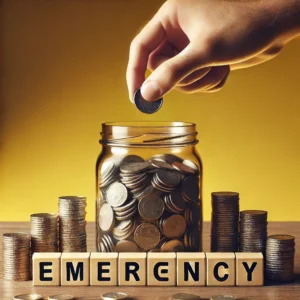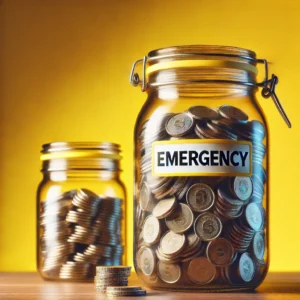
Personal finance is about making sound financial decisions to ensure a stable and prosperous future. One of the most important aspects of financial planning is having an emergency fund. An emergency fund is essentially a reserve of money set aside to cover unexpected expenses or financial emergencies. Whether it’s an unforeseen medical bill, an emergency car repair, or a sudden loss of income, having an emergency fund can help cushion the blow and provide peace of mind during times of financial distress.
In this article, we will explore the significance of having an emergency fund, how much you should aim to save, where to keep it, and how to build one. By understanding the role of an emergency fund in personal finance, you can take the necessary steps to secure your financial future.
Why Emergency Funds Are Essential
1. Provides Financial Security
Emergencies, by their nature, are unpredictable. Life can change in an instant—one minute, everything is fine, and the next, you might be facing a job loss, a health crisis, or a car accident. These events often come with significant expenses. Without an emergency fund, individuals may be forced to rely on credit cards, loans, or borrowing from family and friends, all of which can create a financial burden that lasts long after the emergency is over.
An emergency fund provides a financial cushion, ensuring that you can pay for unexpected expenses without derailing your financial stability. Whether it’s a sudden medical emergency or a home repair, having an emergency fund ensures you won’t have to take on debt or make drastic financial decisions during a crisis. It allows you to weather the storm without sacrificing your long-term financial goals.
2. Prevents Debt Accumulation
When a financial emergency strikes, many people turn to credit cards or personal loans to cover costs. This approach can lead to high-interest debt, which can be difficult to repay over time. Credit cards, in particular, can carry interest rates of 20% or higher, making it easy to accumulate significant debt that can take years to pay off.
If you have an emergency fund, you can cover the expense immediately without resorting to high-interest borrowing. By doing so, you avoid the cycle of debt and prevent interest charges from accumulating. This, in turn, saves you money in the long run and helps preserve your credit score, as you won’t need to rely on borrowing to cover emergencies.
3. Reduces Stress During Difficult Times
Unexpected financial challenges are stressful enough without worrying about how to pay for them. When you have an emergency fund, you don’t have to face the added anxiety of figuring out how to cover the costs. Instead, you can focus on solving the problem at hand—whether it’s recovering from an illness, finding a new job, or getting your car fixed.
Having a financial safety net reduces the emotional strain of facing an emergency, allowing you to make clear, thoughtful decisions without the added stress of financial worry. This peace of mind is invaluable, as financial stress is a leading cause of anxiety for many people.
4. Improves Financial Flexibility
An emergency fund doesn’t just protect you in times of crisis—it also provides flexibility in your everyday financial life. For example, if you lose your job, an emergency fund can give you the freedom to search for a new job that better aligns with your career goals, rather than settling for the first offer that comes your way out of financial necessity.
In other words, having an emergency fund enhances your ability to make choices based on what’s best for your life, not just what’s financially necessary. Whether it’s quitting a job that’s no longer a good fit or waiting for the right opportunity to invest, your emergency fund provides the breathing room to make decisions without the pressure of financial constraints.
How Much Should You Save in an Emergency Fund?
1. General Guidelines
Financial experts generally recommend saving between three to six months’ worth of living expenses in an emergency fund. This amount is considered sufficient to cover basic needs such as housing, utilities, food, transportation, and insurance premiums during a period of financial hardship, like job loss or unexpected medical expenses.
For example, if your monthly expenses total $3,000, you should aim to save between $9,000 and $18,000 in your emergency fund. This amount will provide you with the financial stability to manage expenses without worrying about running out of money while you recover from the emergency.
2. Tailoring to Your Needs
While the three-to-six-month guideline is a good starting point, the exact amount you should save in your emergency fund depends on your unique financial situation. For instance, if you are self-employed or work in an industry with high job volatility, it’s advisable to lean toward the higher end of the spectrum. Self-employed individuals often experience fluctuations in income, making it more difficult to predict when the next paycheck will come. As such, having a larger emergency fund can provide extra peace of mind.
Conversely, if you have a stable, salaried job with a predictable income, you may feel comfortable with a smaller emergency fund. Similarly, if you are single with fewer financial obligations, you might not need as large a fund as someone who has a family to support. Your emergency fund should reflect your risk tolerance and personal circumstances.
3. Adjusting Over Time
As your financial situation evolves, so should your emergency fund. If your monthly expenses increase—due to a new mortgage, a new car, or the birth of a child—your emergency fund goal will need to be adjusted accordingly. Additionally, if your income increases or you pay off debts, you may find that you can reach your emergency fund target more quickly.
It’s important to periodically review your emergency fund and adjust it to reflect changes in your life. A review once a year is a good rule of thumb to ensure that your fund is still sufficient for your needs.
Where Should You Keep Your Emergency Fund?
1. Liquidity is Key
The key characteristic of an emergency fund is liquidity. Liquidity refers to how quickly and easily an asset can be converted into cash without losing value. An emergency fund should be kept in an account that allows for quick, penalty-free access when you need it the most.
Some of the best options for storing your emergency fund include:
-
High-Yield Savings Accounts: These accounts offer higher interest rates than traditional savings accounts, allowing your emergency fund to grow over time. They are also easily accessible and often come with no withdrawal penalties.
-
Money Market Accounts: These accounts offer liquidity similar to high-yield savings accounts, but they may come with slightly higher interest rates and may require a higher minimum balance.
-
Certificates of Deposit (CDs): While not as liquid as savings or money market accounts, short-term CDs (e.g., 3 to 6 months) can be an option if you don’t anticipate needing your emergency fund in the short term. Be aware of early withdrawal penalties if you need access before the maturity date.
2. Avoid Risky Investments
Although the stock market and other investment vehicles may offer higher returns, they are not suitable for an emergency fund. The primary purpose of an emergency fund is to provide safety and security. If your emergency fund is invested in stocks or bonds, there is a risk that its value could decrease at the time when you need it most. Emergencies are unpredictable, and the last thing you want is to be forced to sell investments at a loss during a financial crisis.
Instead, keep your emergency fund in a safe, liquid account that allows you to access your money at any time, without worrying about market fluctuations.
3. Automating Your Savings
One of the easiest ways to build and maintain an emergency fund is by setting up automatic transfers. You can set up a direct deposit from your paycheck or schedule monthly transfers from your checking account to your emergency fund. Automating your savings ensures that you consistently contribute to your emergency fund, even if you forget to do it manually. Over time, these small contributions will add up, and your emergency fund will grow steadily.
How to Build Your Emergency Fund
1. Start Small and Stay Consistent
Building an emergency fund can feel overwhelming, especially if you have no savings or are just starting out. However, the key is to start small and remain consistent. Even if you can only contribute $50 to $100 per month at first, the important thing is to start building the habit of saving. As your financial situation improves, you can increase the amount you contribute each month.
2. Cut Unnecessary Expenses
One of the fastest ways to build your emergency fund is by cutting back on non-essential spending. Take a close look at your monthly expenses and identify areas where you can reduce spending. For example, consider cooking at home instead of dining out, canceling subscription services you don’t use, or reducing impulse purchases. The money you save by cutting these expenses can be redirected into your emergency fund.
3. Use Windfalls and Extra Income
Whenever you receive unexpected money—whether it’s a tax refund, a bonus at work, or a financial gift—consider using part of it to boost your emergency fund. Windfalls provide a great opportunity to make a significant deposit into your emergency savings without affecting your regular budget. This can help you reach your emergency fund goal much faster.
4. Reevaluate Your Emergency Fund Regularly
As your financial situation changes, it’s important to regularly reassess your emergency fund. Review your living expenses, income, and financial goals at least once a year to ensure that your emergency fund is still adequate. If you’ve experienced significant changes—such as buying a house, having a child, or changing jobs—you may need to adjust your savings goals accordingly.
What to Do if You Need to Use Your Emergency Fund
1. Use It Only for True Emergencies
Your emergency fund is meant for unforeseen, urgent situations only. Avoid using it for planned expenses, such as buying a new car or going on vacation. Only dip into your emergency fund if there’s a real crisis that threatens your financial stability, such as medical emergencies, job loss, or essential home repairs.
2. Replenish Your Fund Quickly
If you need to use your emergency fund, make it a priority to replenish it as soon as possible. Ideally, this should be done by cutting back on non-essential expenses or reallocating funds from other savings goals. Building your emergency fund back up ensures that you are always prepared for future emergencies.
An emergency fund is a vital part of personal finance. It provides financial security, prevents debt accumulation, reduces stress, and enhances flexibility. By following the steps outlined in this article, you can build a robust emergency fund that will help protect you from life’s uncertainties. Start small, stay consistent, and make your emergency fund a priority to ensure that you’re financially prepared for whatever comes your way.
Visit our other website: https://synergypublish.com


